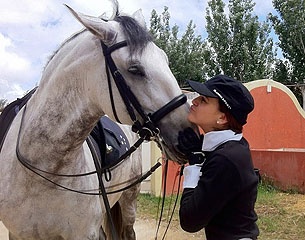
Don’t be afraid to fail. We have been to competitions where we watch riders hold the horse up, clamp their legs on and pray that nothing goes wrong. That is not really riding, that is error prevention, and it is neither pretty nor good for the horse's health. The key in being able to ride and then relax requires one element which riders must learn to work with in training. The ability to let the mistake happen.
My coach tells me that “we must let the mistake happen in order for the horse to learn he must stay on his own. He must use his own strength and find his own balance."
If we begin the half pass, clamp our leg on and push all the way across, the horse learns to rely on the force of the leg and not on learning the aid that tells him to stay in half pass alone. If you ask the half pass and then relax the aid, you may lose the half pass for a stride, but when you ask again and relax, the horse will go “Oh ok, so she asks and I must then stay in the half pass until asked otherwise."
Have you ever seen a rider overriding the canter and the minute they stop banging and crashing about the horse falls to trot? Why does this happen? Because the rider has taught the horse that unless they are pushing constantly, he does not have to keep cantering. There is a vast difference between controlling every step and riding every step. The good riders will know to ask and then relax and teach the horse to do it alone.
A great example is the collected canter. We see the best riders will come into a pirouette, ask the horse to collect, and then simply steer the shoulders around the quarters. An over-doer will come in, ask the horse to collect, keep asking the horse to collect, keep asking the horse to keep catering in collected canter, and then push every stride around the pirouette to keep the horse in canter.
How did the first rider create this setup to perform this sort of pirouette? Quite possibly at one stage or another he allowed the horse to quit and then asked again very quickly. If you are in canter and you ask the horse to collect, you use your seat and the minute he collects you relax, and if he loses the canter, you give a tuck tuck, so he goes 'oh ok, she asks me to collect and then I must maintain it even when she relaxes!'
Gradually the horse learns to collect and maintain the canter even when you have relaxed your seat, which then enables you to do the delightful thing of allowing more in front, so the horse can come up and out the front door.
A rider who is asking all the time that the horse stays in collected canter, or any canter for that matter, will never really be able to allow the horse his freedom in front, because they lack the ability to control the movement and relax at the same time.
Think of it when you begin. Does my horse move off a light leg aid or do I push continuously to keep the horse moving? You can do this even when you first start on a loose rein in free walk. Do you push the whole time? Does the horse walk alone? If not, be PICKY! Give the aid to go forward, then relax, if he stops, give the aid again slightly more sharply, then relax.
Don’t be worried that the horse might make the mistake and stop, be worried that if he doesn’t make the mistake, and you keep pushing and pushing and pushing, you will be pushing your way into a clamped up, overridden mess that will leave you exhausted and you horse in a knot!
by Sarah Warne
Related Links